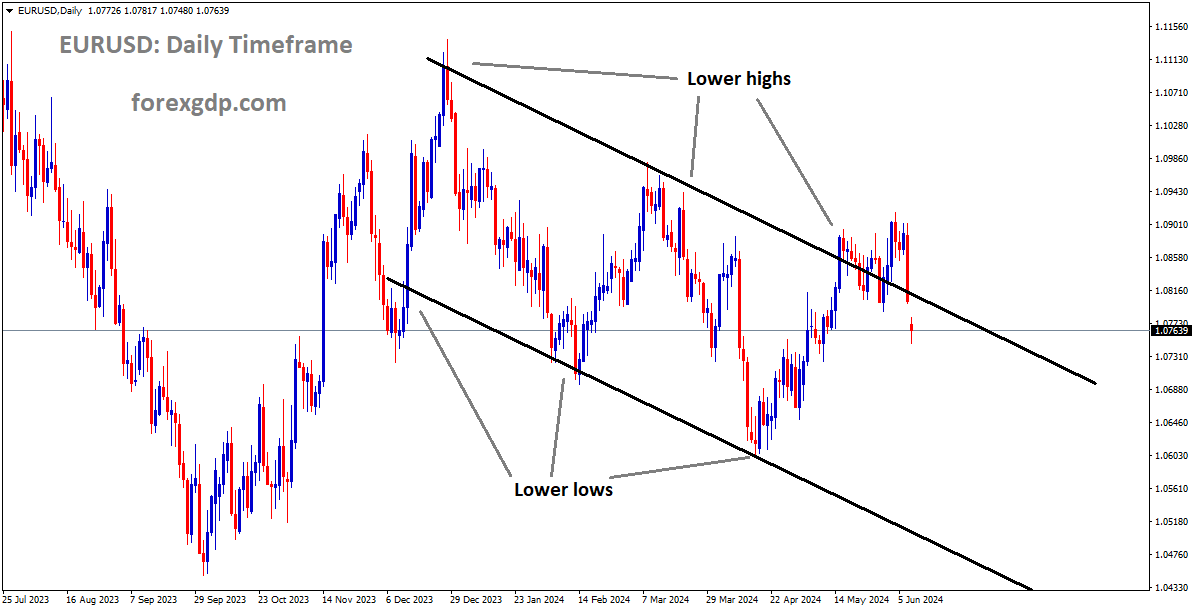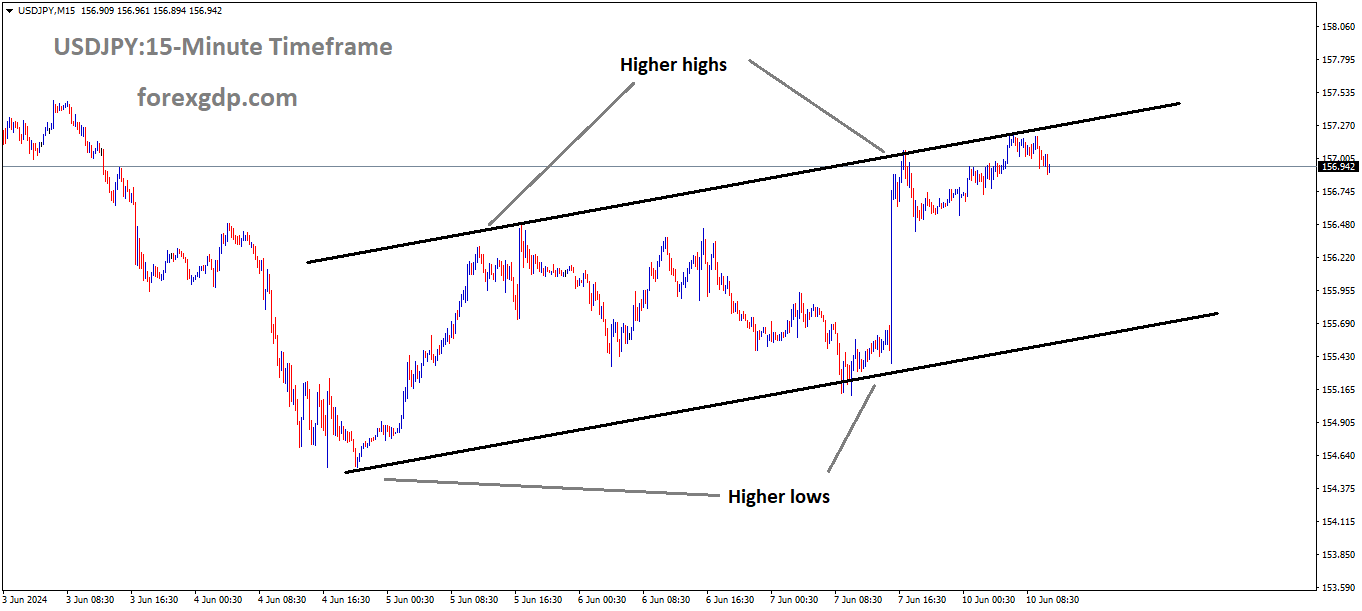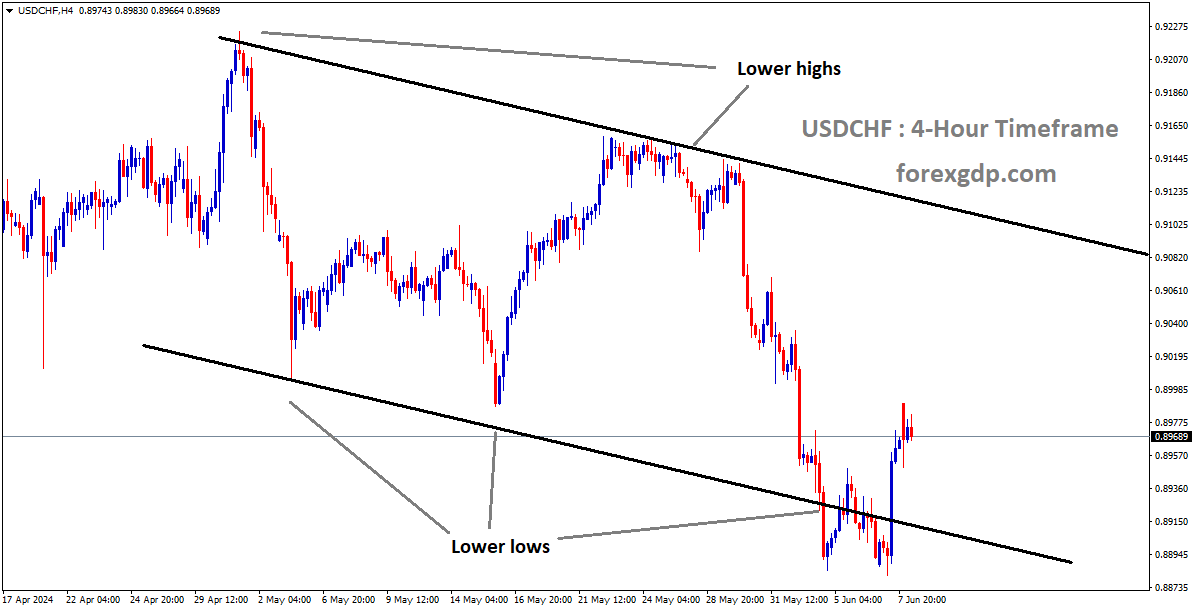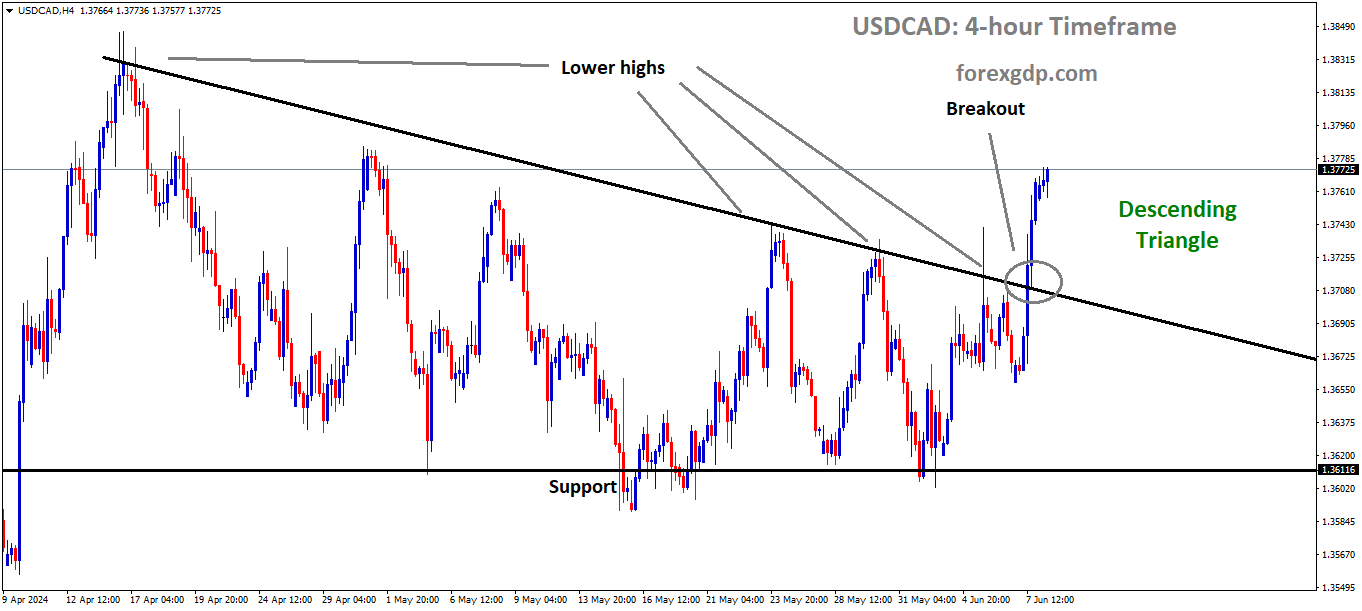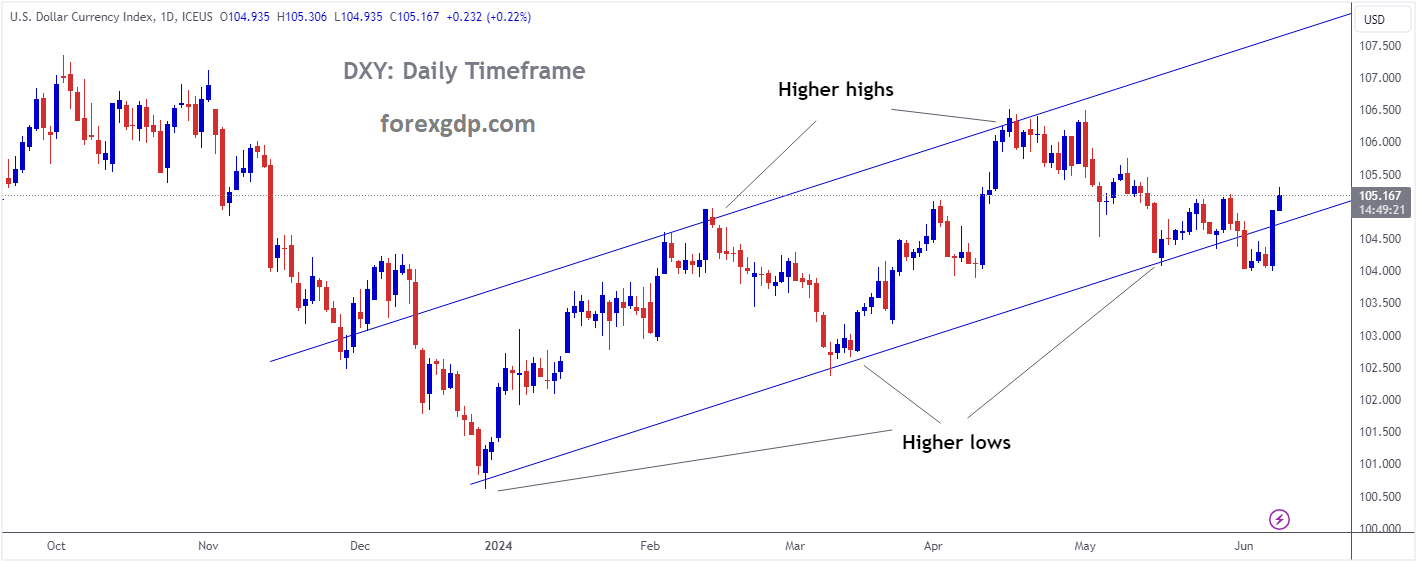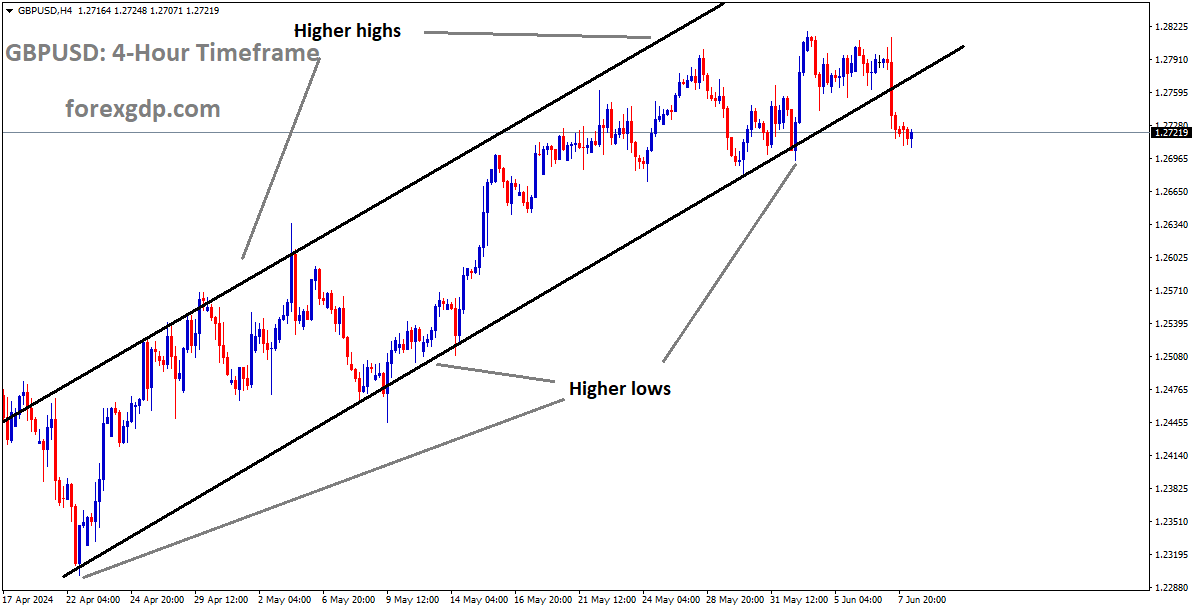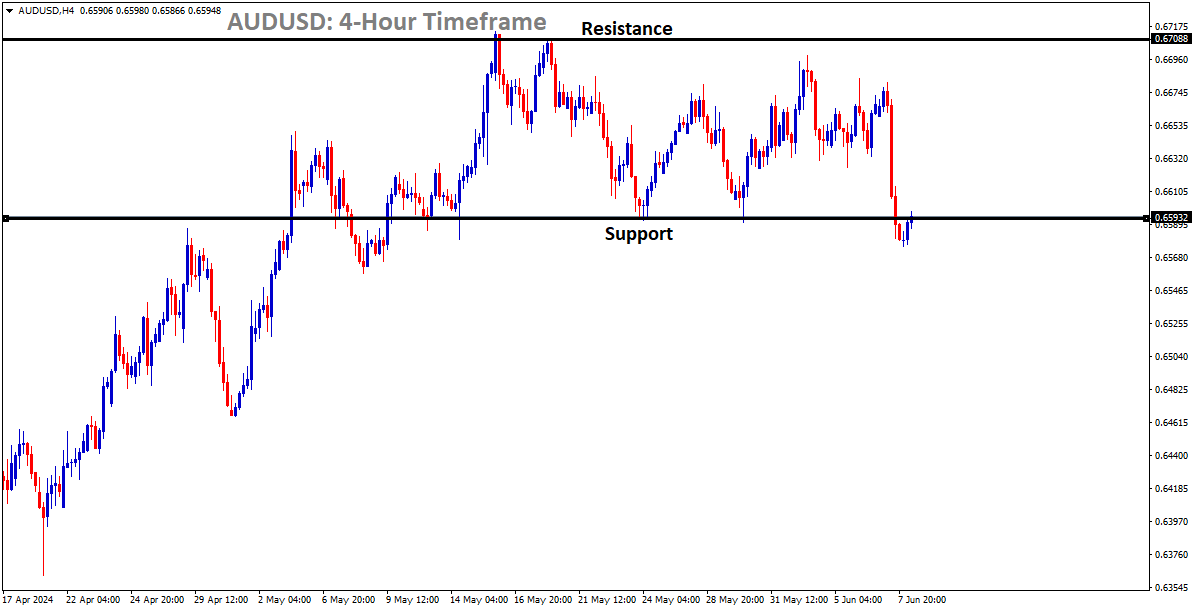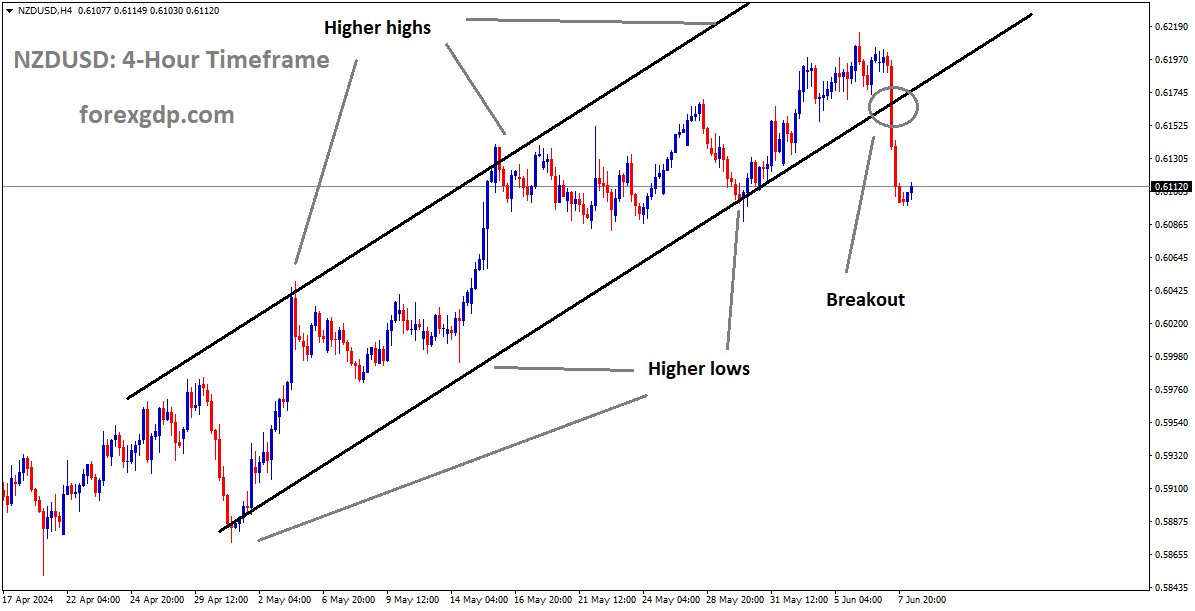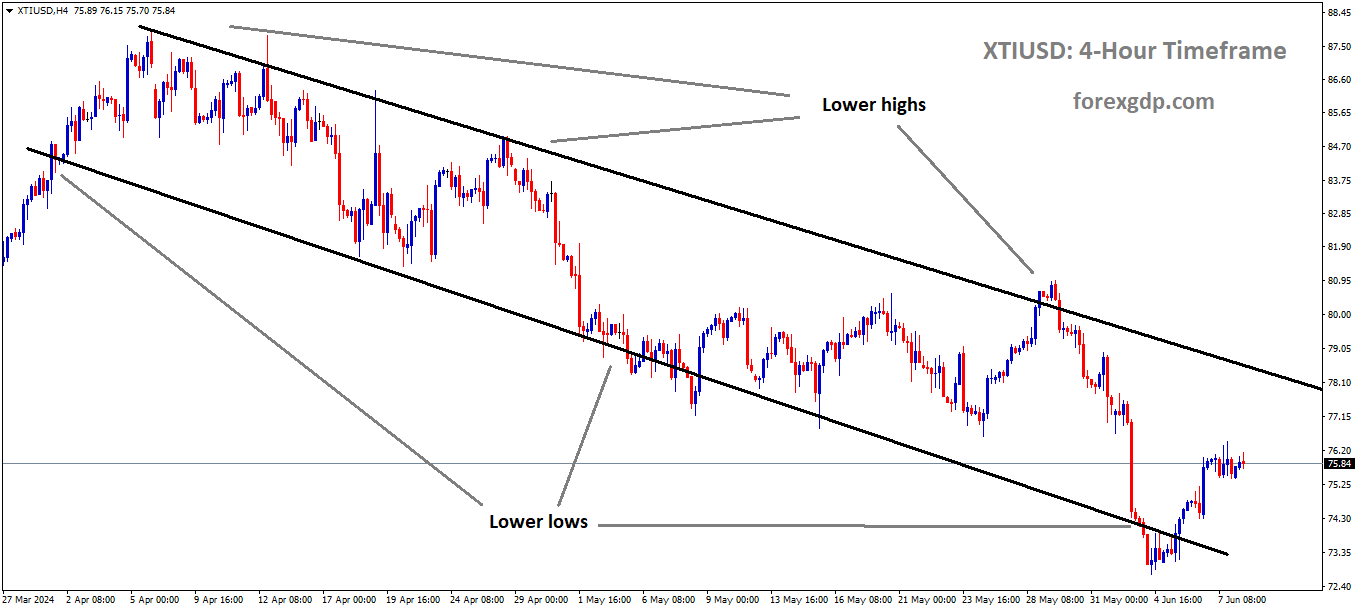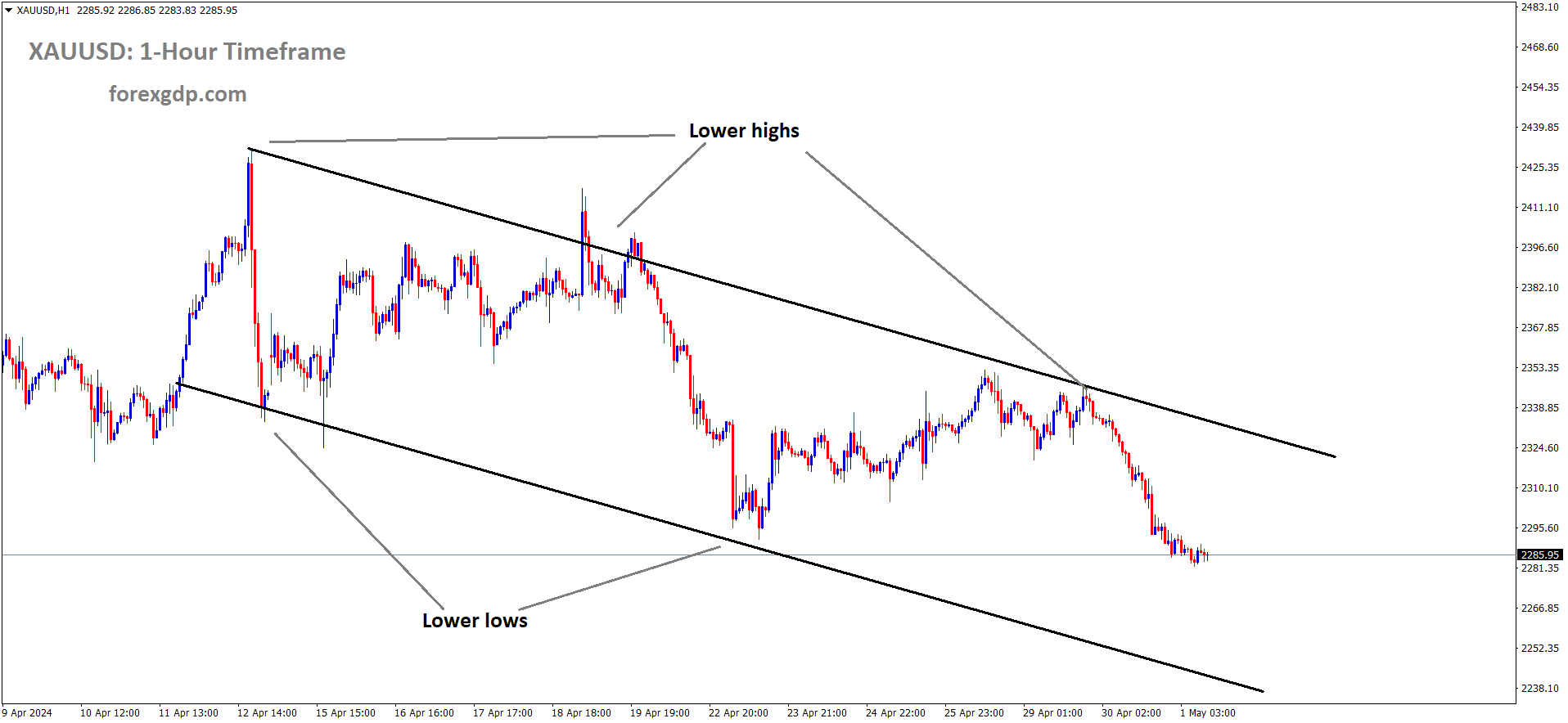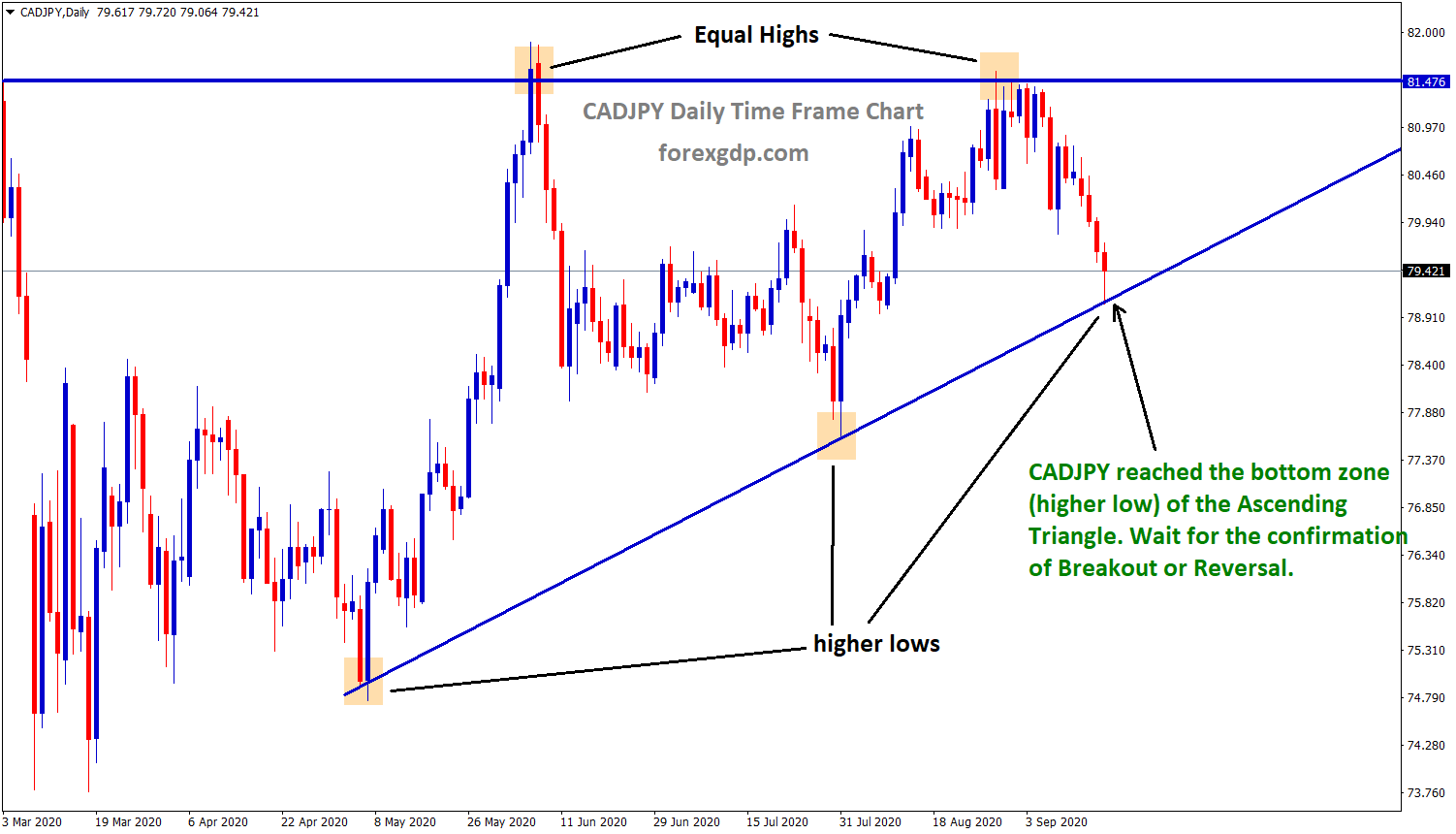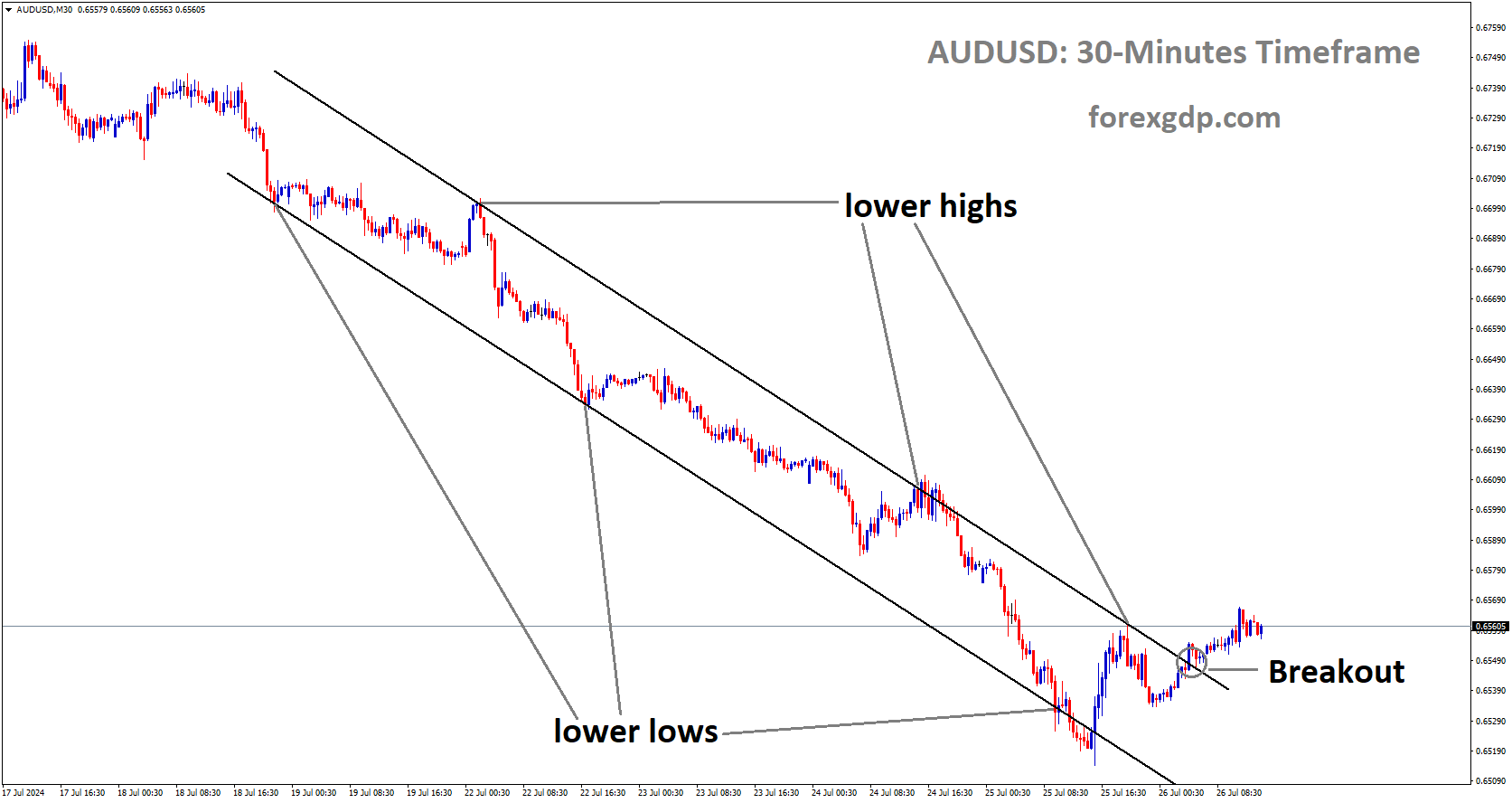XAUUSD – Gold Price Attracts Sellers Near One-Month Low Amid Stronger US Dollar
Gold prices are moved lower after the china said they are currently paused Gold purchases after the 18 month continuous purchases. US FED rate cut bets are lower due to hot Job Numbers makes Gold down against USD.
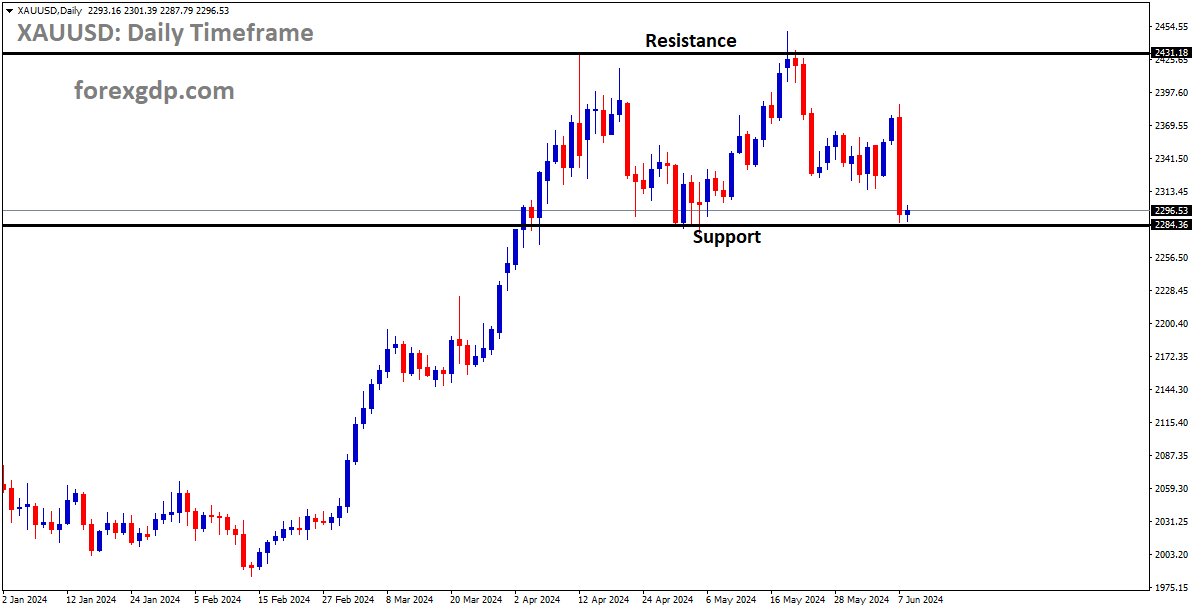
XAUUSD is moving in the Box pattern and the market has reached the support area of the pattern
The price of gold (XAU/USD) has entered a phase of bearish consolidation, hovering near its lowest level in over a month, staying below the $2,300 mark during the early European session on Monday. This decline follows the release of the Nonfarm Payrolls (NFP) report, which revealed that the US economy created significantly more jobs than expected in May. This development led investors to scale back their expectations for a September interest rate cut by the Federal Reserve (Fed), resulting in elevated US Treasury bond yields and pushing the US Dollar (USD) to nearly a one-month high. Consequently, these factors act as headwinds for gold, given its non-yielding nature.
Moreover, reports indicating that the People’s Bank of China (PBoC) halted gold purchases for its reserves in May, ending an 18-month buying spree, further undermine the price of gold. Despite this, a cautious market sentiment provides some support to the safe-haven appeal of XAU/USD, helping to limit deeper losses. Traders are also displaying reluctance to make aggressive directional bets ahead of key US data releases and central bank events later in the week, including the latest US consumer inflation figures and the outcome of the two-day FOMC policy meeting.
The upbeat US employment data released on Friday fueled speculation that the Federal Reserve might delay initiating a rate-cutting cycle, thus capping the upside potential for gold. The NFP report revealed that the US economy added 272,000 jobs in May, surpassing expectations, while Average Hourly Earnings also exceeded consensus estimates, increasing by 4.1% year-over-year.
Following the release of the data, the yield on the benchmark 10-year US government bond surged to 4.45%, with the rate-sensitive 2-year yield remaining close to 5.0%, supporting the US Dollar and acting as a barrier for XAU/USD.
Furthermore, the decision by the People’s Bank of China to cease gold buying after 18 months raised concerns about decreasing demand for gold, favoring bearish traders. Investors are adopting a wait-and-see approach ahead of upcoming data releases and the FOMC monetary policy decision, with the probability of a rate cut in September falling to around 50% following the US jobs data. Therefore, investors will closely monitor fresh signals regarding the timing of potential Fed interest rate cuts amid the resilient US economy, which will significantly influence the next directional move for gold.
EURUSD – ECB’s Holzmann: More Rate Cuts Could Impact Euro and Boost Inflation
The ECB Policy maker Robert Holzmann said ECB may be do further rate cuts depends on data upcoming printing in the following months. The ECB action of Rate cut would pressure Euro currency and inflation due to absence of FED rate cuts in the market.
EURUSD is moving in the Descending channel and the market has fallen from the lower high area of the channel
European Central Bank (ECB) policymaker Robert Holzmann remarked on Saturday that it remains premature to ascertain if the ECB has commenced a trajectory towards decreased borrowing costs subsequent to its decision to reduce its benchmark interest rate during its June meeting last week, as reported by Reuters.
Holzmann additionally articulated that further rate reductions by the ECB in the absence of corresponding actions from the US Federal Reserve (Fed) could exert influence on the Euro exchange rate and inflation.
USDJPY – Japan Q1 GDP -0.5% QoQ, meets expectations
The Japan Q1 GDP data came at -0.50% QoQ versus -0.50% printed in the last quarter. Annualised GDP data came at -1.8% QoQ versus -2.0% QoQ in the previous quarter. Japanese Yen loses Ground against Counter pairs after the Q1 GDP came at expected data.
USDJPY is moving in an Ascending channel and the market has fallen from the higher high area of the channel
The Japanese Gross Domestic Product (GDP) for the first quarter (Q1) experienced a contraction of 0.5% quarter-on-quarter (QoQ), according to data released by the Cabinet Office on Monday. This result matched both the expected contraction of 0.5% and the contraction reported for the previous quarter.
Additionally, on an annualized basis, the GDP for Q1 shrank by 1.8%. This figure was slightly better than the anticipated contraction of 1.9% and an improvement over the previous reading, which showed a contraction of 2.0%.
USDCHF – Gains on Strength in US Labor Market
The SNB rate cut in the March month to 1.50%, This month June 20 is next probability of rate cut from SNB due to lower inflation sustaining in the market. The Swiss Franc is moved higher after the SNB Told intervention in the FX due to bolstering of Swiss Franc in the economy.
USDCHF is moving in the Descending channel and the market has rebounded from the lower low area of the channel
The USD/CHF pair is experiencing a surge following the unveiling of updated Nonfarm Payroll (NFP) figures from the US last Friday, which surpassed market anticipations. As speculations rise regarding a potentially more hawkish stance from the Federal Reserve, the divergences with the Swiss National Bank (SNB) may tilt the scales in favor of the USD.
The latest NFP report for May revealed a substantial increase to 272,000, up from April’s revised figure of 165,000, significantly outpacing market projections of 185,000. Such robust data has led to a reduction in the likelihood of a Fed rate cut occurring in September. Concurrently, the Unemployment Rate in the US ticked up to 4% from the previous 3.9%, accompanied by a slight dip in the Labor Force Participation Rate, declining to 62.5% from the prior 62.7%. Additionally, Average Hourly Earnings saw a year-on-year growth of 4.1% from the revised 4% recorded in April, signaling an increase in wage inflation.
Following the data release, US Treasury yields witnessed a sharp uptick, with the 2-year, 5-year, and 10-year rates surging to 4.80%, 4.44%, and 4.41%, respectively, amplifying the appeal of the USD.
Contrarily, the SNB initiated an easing cycle during its March meeting, cutting rates by 25 basis points to reach 1.5%. Presently, the market anticipates a 55% probability of another rate cut occurring at the upcoming meeting scheduled for June 20.
USDCAD – Stable Above Mid-1.3700s, Near Early May Highs
The US Dollar strong rallied against CAD after the US NFP Data came at 272K in the May month from 188K printed in the last month. Canadian Dollar weakness by BoC rate cut in the last week, Employment changes are higher in the May month. OPEC+ Oil Output cuts is also decline for Canadian Dollar in the market.
USDCAD has broken the Descending triangle pattern in upside
Amid the Asian session on Monday, the USD/CAD pair struggles to maintain momentum following the post-NFP movement, wavering with modest gains or minor losses, hovering just above the mid-1.3700s. The subdued price dynamics reflect a blend of conflicting factors, although the fundamental landscape appears tilted in favor of bullish traders.
The US Dollar (USD) ascends to nearly a four-week pinnacle on the back of anticipations that the Federal Reserve (Fed) will prolong higher interest rates, buoyed by the enduring resilience of the US economy, accentuated by Friday’s robust US labor market data. The prevailing hawkish sentiment continues to bolster US Treasury bond yields, concurrently supported by a cautious market sentiment, thus providing impetus for the safe-haven USD and the USD/CAD pair.
Conversely, Crude Oil prices exhibit signs of recovery, seeking to extend gains from the previous week’s rebound off a four-month trough, following remarks from OPEC ministers affirming their intent not to augment supply if prices remain subdued. This development is perceived to bolster the commodity-linked Canadian Dollar (CAD), consequently restraining the upside potential of the USD/CAD pair. Additionally, traders exhibit reluctance to engage in aggressive directional trading ahead of this week’s US macroeconomic data releases and central bank event risk.
Scheduled for Wednesday, the impending release of the latest US consumer inflation metrics will be closely monitored, alongside the much-anticipated outcome of the FOMC monetary policy deliberations. These events will play a pivotal role in shaping investor sentiment regarding the prospective commencement of the Fed’s rate-cutting cycle, consequently influencing the trajectory of the USD. In the interim, speculations surrounding a potential rate reduction by the Bank of Canada (BoC) in the ensuing month may serve as a supplementary catalyst for the USD/CAD pair.
USD INDEX – US Dollar Rebounds as Strong NFP Figures Could Delay Rate Cuts
US Dollar moved higher after the Last week NFP data, unemployment rate came at higher than expected. FED rate cut in the September month is now doubtful due to hot job market numbers and average Hourly earnings report.
USD INDEX is moving in an Ascending channel and the market has reached the higher low area of the channel
On Friday, the US Dollar Index (DXY) continued its upward trend, propelled by stronger-than-expected labor market data. The Nonfarm Payrolls report, coupled with an uptick in wage inflation, underscored the resilience and strength of the economy, potentially justifying a postponement of rate cuts by the Federal Reserve (Fed).
Market attention now shifts to upcoming Fed meetings, with investors closely monitoring any shifts in monetary policy stance following the positive labor data. With the robust employment figures, the probability of rate cuts for June and July has diminished, dropping to approximately 50% for September.
The latest economic indicators paint a promising picture:
Nonfarm Payrolls for May surged to 272,000, surpassing market forecasts of 185,000 and marking significant growth from April’s revised figure of 165,000.
The Unemployment Rate experienced a slight uptick to 4% from 3.9%.
Wage inflation, represented by the percentage change in Average Hourly Earnings, rose to 4.1% on a yearly basis, rebounding from the revised 4% in April.
Furthermore, Treasury yields mirrored the upward trajectory, with the 2-year, 5-year, and 10-year rates climbing over 2% to reach 4.85%, 4.44%, and 4.41%, respectively.
GBPUSD – Stays Defensive Below 1.2750 Amid Stronger US Dollar
The GBP Pairs are moving higher ahead of Employment change, Cliamant count change readings schedule this week. Last week NFP data shows robust numbers, but FED rate cut from September month moved GBP against USD in higher path.
GBPUSD is moving in an Ascending channel and the market has reached the higher low area of the channel
During early Asian trading hours on Monday, the GBP/USD pair rebounds modestly around 1.2725. However, the potential upside of the GBP/USD pair may be curtailed due to diminishing expectations of US Federal Reserve (Fed) rate cuts this year following the release of stronger-than-expected US Nonfarm Payrolls (NFP) data. Market participants are closely monitoring the upcoming UK employment data for May scheduled for release on Tuesday. Additionally, focus remains on the US Consumer Price Index (CPI) and the Fed’s interest rate decision later this week.
In May, the US Nonfarm Payrolls surged by 272,000, surpassing April’s increase of 165,000 and market expectations of 185,000. Meanwhile, the Unemployment Rate inched up to 4.0% from April’s 3.9%. The Average Hourly Earnings also recorded a growth of 4.1% year-over-year in May, improving from April’s revised figure of 4.0% and outperforming the consensus estimate of 3.9%, as reported by the US Bureau of Labor Statistics.
The robust US employment report has tempered expectations of rate cuts by the Federal Reserve (Fed), with futures traders foreseeing minimal likelihood of a rate cut before September, according to data from CME Group. This “higher-for-longer” stance on US rates is anticipated to bolster the US Dollar (USD) in the near term.
Conversely, the UK Employment data slated for release on Tuesday, encompassing metrics such as Claimant Count Change, Employment Change, and Average Earnings, could influence market sentiment. Any indications of heightened job losses may fuel expectations of preemptive rate cuts by the Bank of England (BoE), potentially weakening the Pound Sterling (GBP).
AUDUSD – Australian Dollar Rises as RBA Eyes Policy Rate Hike
The RBA Governor Michelle Bullock said further rate hikes are possible in the market due to higher inflation readings are prevailing in the market. China Trade surplus widened in the May month is supportive for Australian Dollar against Counter pairs. US NFP data came at robust numbers moved Australian Dollar down against USD on Friday.
AUDUSD is moving in the Box pattern and the market has reached support area of the pattern
The Australian Dollar (AUD) exhibited upward movement on Monday, rebounding from its decline in the preceding session. Conversely, the US Dollar (USD) regained strength following the release of robust US employment data on Friday, prompting traders to revise their expectations regarding potential rate cuts by the Federal Reserve (Fed). Consequently, pressure mounted on the AUD/USD pair.
Despite this, the Australian Dollar may mitigate its downside risks due to the hawkish sentiment surrounding the Reserve Bank of Australia (RBA). RBA Governor Michele Bullock recently hinted at the central bank’s readiness to raise interest rates if the Consumer Price Index (CPI) fails to return to the target range of 1%-3%, as reported by NCA NewsWire.
Furthermore, the US Dollar extended its gains on the back of increasing US Treasury yields, supported by a strong US jobs report that reinforces a hawkish stance from the Federal Reserve. Notably, the CME FedWatch Tool indicates a decrease in the likelihood of a Fed rate cut in September by at least 25 basis points, dropping to nearly 48.0% from 54.8% a week earlier.
In its report, Rabobank suggested the possibility of Federal Reserve rate cuts in September and December, primarily due to a deteriorating economy rather than progress on inflation. The analysis reflects a belief that the US economy is entering a stagflationary phase, characterized by persistent inflation and an economic slowdown that may culminate in a mild recession later this year.
On Friday, data from the US Bureau of Labor Statistics (BLS) revealed that May’s US Nonfarm Payrolls (NFP) surged by 272,000, up from 165,000 in April. Additionally, wage inflation, measured by Average Hourly Earnings, increased by 4.1% year-over-year in May, surpassing market expectations.
Meanwhile, the National Bureau of Statistics of China reported that Trade Surplus widened to $82.62 billion year-over-year in May, exceeding expectations and the previous balance. However, imports rose by a smaller margin than anticipated, while exports experienced a decline, potentially impacting the Australian market given the close trade ties between the two nations.
In Australia, May’s Trade Balance widened, surpassing expectations, with a notable decline in imports and exports. Additionally, Initial Jobless Claims in the US rose unexpectedly, signaling potential challenges in the labor market.
NZDUSD – Holds Near 0.6100 After Recent Losses
The NZ Dollar moved lower after the US NFP data came at higher than expected last day. RBNZ is clear statement of rate cut is not possible due to higher rates prevailing in the market. The NZ Finance Minister Nicola Willis said Prolonged rate hikes is not better for Budget spending plan in the coming years.
NZDUSD has broken the Ascending channel in downside
The resurgence of the US Dollar (USD) was fueled by robust US employment data released on Friday, prompting speculation that the Federal Reserve (Fed) might postpone rate cuts. Consequently, the NZD/USD pair faced downward pressure.
The increase in US Treasury yields further bolstered the US Dollar’s strength, as a robust US jobs report would reinforce a hawkish stance from the Federal Reserve. Notably, the CME FedWatch Tool indicates a decline in the probability of a Fed rate cut in September by at least 25 basis points, dropping to nearly 48.0% from 54.8% a week earlier.
In a report, Rabobank suggested the possibility of Federal Reserve rate cuts in September and December, primarily due to a deteriorating economy rather than progress in inflation management. Their analysis indicates a potential transition of the US economy into a stagflationary phase characterized by persistent inflation and economic deceleration, potentially leading to a mild recession later this year.
On the Kiwi front, the New Zealand Dollar (NZD) has been supported by the country’s relatively high interest rates despite economic challenges. The Reserve Bank of New Zealand (RBNZ) is expected to maintain a steady policy stance until at least mid-2025, awaiting a comprehensive assessment of data.
However, the NZ Herald reported last week that New Zealand’s Finance Minister, Nicola Willis, emphasized that the 2024 budget would not extend higher interest rates, despite concerns from economists about its potential impact on the RBNZ’s efforts to curb inflation.
CRUDE OIL – WTI Rebounds Near $75.50 on Fed Rate Cut Expectations
The Crudeoil Prices are higher after the rate cuts expected from FED is higher in the September month Polls and OPEC+ agreed for 2.2 Million Barrels output cuts till 2025. US Crudeoil Inventories surged by ending May 31 also boosted Oil prices in the market.
XTIUSD Crude oil price is moving in the Descending channel and the market has rebounded from the lower low area of the channel
During Monday’s Asian trading hours, the intermediate (WTI) Oil price recuperates from the losses incurred in the previous session, hovering around $75.30 per barrel. This upsurge in crude Oil values is primarily attributed to speculations surrounding potential interest rate cuts by the US Federal Reserve (Fed) in September.
However, the anticipation of a Fed rate reduction was tempered by the release of better-than-expected US employment data on Friday. According to the US Bureau of Labor Statistics (BLS), May’s US Nonfarm Payrolls (NFP) surged to 272,000, surpassing the April figure of 165,000. The robust employment figures prompted a surge in demand for the US Dollar (USD), thereby exerting downward pressure on Oil prices by rendering the commodity costlier for buyer nations transacting in alternate currencies.
The outlook for Crude Oil values could face headwinds if borrowing costs persist at elevated levels over an extended period, potentially dampening Oil demand. A robust US jobs report is indicative of a hawkish stance from the Federal Reserve, a scenario corroborated by the CME FedWatch Tool, which indicates a reduced likelihood of a Fed rate cut in September, currently standing at around 48.0%, down from 54.8% recorded a week earlier.
Furthermore, apprehensions regarding a potential supply glut in the Oil market have mounted following the decision by the Organization of the Petroleum Exporting Countries and its allies (OPEC+) to gradually phase out voluntary production cuts implemented by eight member countries, commencing in October. By December, it is anticipated that over 500,000 barrels per day (bpd) will re-enter the market, with a cumulative influx of 1.8 million bpd anticipated by June 2025.
Don’t trade all the time, trade forex only at the confirmed trade setups
Get more confirmed trade signals at premium or supreme – Click here to get more signals , 2200%, 800% growth in Real Live USD trading account of our users – click here to see , or If you want to get FREE Trial signals, You can Join FREE Signals Now!



